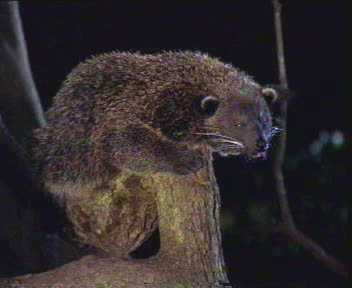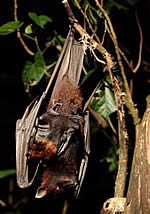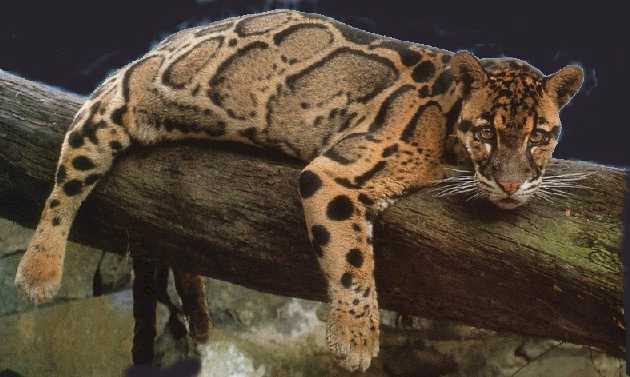|
Night
Safari Walking Trails


Animals
on the Leopard
Trail
|
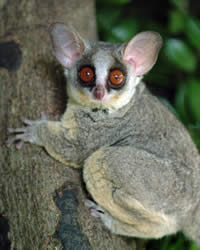
|
Animal
Name: Lesser
Bush Baby (or
Senegal Galago)–
Introduced in Jun 2005!
Scientific
Name: Galago
senegalensis.
Range:
Africa
Habitat:
African rainforests
& sub-Saharan parts of Africa.
Diet:
Mainly insects, also flowers,
pollen, honey, seeds, fruit, resin, lizards, mice and nestlings.
Social structure: Social,
forms family groups while foraging. Often in larger groups
when sleeping.
Life Span:
Captivity - 15
years.
Conservation/status:
Populations are
currently stable throughout their range.
Remarks: The
bush baby is a primate. The first European explorers gave
this animal its name because the bush baby's calls sounded
like the shouts of an excited child. Of the 6 species of
African bush babies, the lesser bush baby is the most widespread.
The bush baby urinates on branches etc. to scent mark its
territory. It is also known to wash itself in its own urine.
The bush baby is an important pollinator of rainforest flowers.
The longest leap made by a bush baby measured at 7m! The
highest standing jump is at 2.25m! The hind legs are longer
than the fore limbs to aid in jumping. The elongated lower
leg bones provide greater leverage for moving quickly from
a standstill. The digits or toes are 'flattened' at the
ends with pads of thick skin to give better grip. There
is also a special grooming claw on the second toe of each
hind foot. The second digit of each fore foot is shorter
than the rest for better grip as well.
Read more
bush baby info
on the official NS website.
|
|
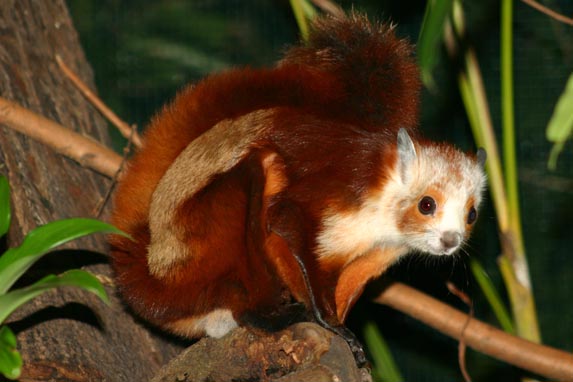
|
Animal
Name:
Red and White Giant Flying Squirrel –
Introduced in Apr 2004!
Scientific
Name: Petaurista
alborufus.
Range:
Eastern Afghanistan
to Java, and from Kashmir, Taiwan, and southern China to
Sri Lanka, and mostly in the forest regions of Pakistan.
Habitat:
Temperate forest
& rainforest, tropical deciduous forest
Diet:
Pine cones, tree buds, leaves,
young branches, and, when in season, various fruits and
nuts. In captivity, they are fed raisins and nuts, but refused
shrubs and other leafy substances.
Social structure: Solitary.
Life Span:
Captivity - 16
years.
Conservation/status:
Common within
their geographic range, but deforestation has significantly
decreased the size of their habitats.
Remarks: Has
thickly haired membrane that extends from its wrists to
its hind legs and is further expanded by a skin fold between
the tail root and the hind legs. This
membrane is composed of sheets of muscles that can be tensed
or relaxed at will to control the direction of glide. In
addition, there is a large spur on the edge of this membrane
that helps to support it. Giant flying squirrels are excellent
gliders; some were observed gliding for up to 75 metres
! This is accomplished by jumping off an elevation, usually
the topmost branches of a tree. At rest, they fold the flying
membrane close into their bodies
|
|
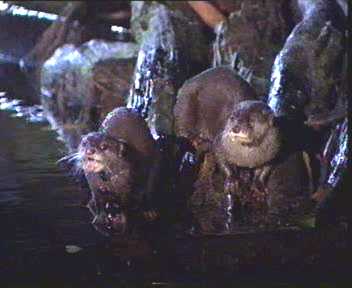
|
Animal
Name: Oriental Small-clawed
Otters
Scientific
Name: Aonyx (amblonyx)
cinerea
Range:
India to southern China,
southeast Asia, Indonesia and Borneo.
Habitat:
Wetlands, mangrove swamps,
river creeks, ponds, lakes, especially where there is some
tree cover.
Diet:
Mainly fish, also eats
crustaceans, shellfish.
Social
structure: Can be solitary
but more often in small family groups.
Life Span:
Up to 20 years.
Conservation/status:
Not threatened though they
are affected by water pollution.
Remarks:
Waterproof fur to keep
body warm, streamlined body designed for swimming, will
overturn rocks on riverbeds with front paws in search of
crustaceans. Can become very vicious when they gang up together
against even much larger intruders.
Read
more about otters
here.
|
|
|
Animal
Name: Binturong (or
Bear Cat)
Scientific
Name: Arctictis binturong
Range:
Southeast Asia, including
Indonesia and Borneo
Habitat:
Dense tropical and sub-tropical
forests, mostly in trees
Diet:
Leaves, shoots, fruits,
berries as well as birds, fish, small mammals and carrion.
Social
structure: Small family
groups consisting of parents and few young
Life Span:
Wild - 18 years, Captivity - A little longer.
Conservation/status:
Not threatened
Remarks:
Easily domesticated and
has been kept as pets by people living near the forests.
Can hang upside-down from a branch using its hind legs and
aided by its prehensile tail.
|
|
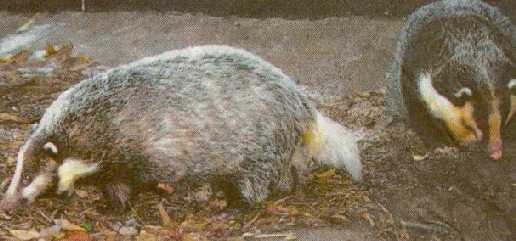
|
Animal
Name: Hog Badger
Scientific
Name: Arctonyx
collaris
Range:
Northeast
India, China and South-east Asia
Habitat:
Forests
(usually hilly or mountainous areas) below 3,000m
Diet:
Earthworms
and other ground-living invertebrates, roots, tubers and
fruits.
Social
structure: Not known, most
likely solitary
Life Span:
Captivity - 14 years
Conservation/status:
Not threatened
Remarks:
The
animal is known commonly as 'hog badger' because of its
pig-like snout, and also possibly because of the way it
searches for food with the snout, similar to what a pig
would do. 'Hog-nosed badger' is another name used for this
species. In Indonesia it is known as pulusan or babi batang.
A special thank
you to VR Tong Jin for providing this info about
the hog badgers.
|
|
|
Animal
Name: Long-tailed
Porcupine
Scientific
Name: Trichys lipura
Range:
Malaya, Borneo and Sumatra.
Habitat:
Dense forests.
Diet:
Roots, earthworms.
Social
structure: Solitary
Life Span:
Wild - 10 to 15 years
Conservation/status:
Endangered due to habitat
destruction..
Remarks:
The tail can be more than
half the length of the porcupine's body. The quills on its
body are short and flattened. They grow in between the hair
and hardly protrude beyond the hair, hence the porcupine
looks like an enormous rat. The tail also ends in a tuff
of long flattened hair. The long tail is useful for balance
whilst the porcupine is climbing trees and moving among
rocks.
|
|
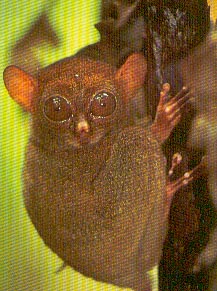
|
Animal
Name: Tarsier (or
devil monkey)
Scientific
Name: Tarsius syrichta
Range:
Southeast Asia, Sumatra,
Borneo, and the Philippines
Habitat:
Lives among trees with
slender stems and branches
Diet:
Mainly insects, will kill
nestlings and small birds
Social
structure: In pairs or
in small family groups.
Life Span:
Up to 12 years.
Conservation/status:
Endangered species, suffers
from habitat loss and are victims of illegal pet trade.
Remarks:
Classified
as a 'prosimian' and is one of the smallest members in the
primate family. It gets its name from the word ‘tarsal’,
meaning anklebone. The tarsier has elongated tarsal that
enables it to leap up to 2metres in distance. It catches
prey by jumping on them and seizing them with its ‘hands’.
Read more about
tarsiers here.
|
|
Mangrove
Walk
|
|
|
|
|
Animal
Name: Malayan or Red-necked
Flying Fox
Scientific
Name: Pteropus
vampyrus.
Range:
From Maldives to Pakistan,
India, Nepal, Sri Lanka Indochina, Southeast Asia and Australia
Habitat:
Roost in trees, hunts in
forests or in orchards
Diet:
Mainly fruit pulps, nectar
and pollen from flowers, flying foxes are the main pollinators
for many fruit trees like the durian trees.
Social
structure: Live in large
colonies
Life Span:
Wild - 15 years, Captivity - 30 years.
Conservation/status:
Not threatened but a pest
to fruit farmers, hunted in Asia for food and its fat for
medicinal purposes, affected by deforestation elsewhere.
Remarks:
Called
flying fox because of its fox-like head. Flying foxes are
the largest bats in the world with a wing span of up to
1.8m ! These bats use their excellent eyesight as their
main form of navigation (fruit doesn’t move). They see very
well in the dark and use their acute sense of smell to detect
fragrant flowers and fruit. Such bats can fly 40km a night
in search of food and they are known to prefer over-ripe
fruit. Bats hang upside down when they roost due to their
awkward physique. They take off by letting go of the branches
and they land in trees by crash landing into them, gripping
the branches for a hold.
Read more about
bats here.
|
|
Animal
Name: Dog-faced
Fruit Bat (or Short-nosed Fruit Bat)
Scientific
Name: Cynopterus
brachyotic
Range:
Sri
Lanka, Southeast Asia, Philippines and Indonesia.
Habitat:
Roost
in trees, hunts in forests or in orchards.
Diet:
Feed
on fruits and nectar in the wild. In captivity, their fruit
diet is supplemented with nectar and fruit juices.
Social
structure: -
Life Span:
-
Conservation/status:
Not
yet threatened in their natural habitat.
Remarks:
This
bat is a unique species in that it constructs roost tents
from the leaves of palm, bananas trees and other large leaf
plants. By chewing the veins, the leaves collapse and form
well engineered roosting cavities, protecting the bats from
the weather and predators.
Read more about
bats here.
|
|
|
Animal
Name: Masked Lapwing
(or Masked Plover, Spur-winged Plover, Plover)
Scientific
Name: Vanellus miles
Range:
New Guinea and Australia
Habitat:
Open habitats with short
grass and close to water, wetlands, sheltered coastal regions,
common in urban areas too.
Diet:
Insects, worms, spiders,
crustaceans, molluscs, seed leaves
Social
structure: Form breeding
pairs all year round, and live with other pairs in flocks
Life Span:
At least 12 years
Conservation/status:
Not threatened
Remarks:
Masked
Lapwings are ground-dwelling birds that are closely related
to the waders. They are unmistakable in both appearance
and voice, which is a loud "kekekekekekekek".
Birds have large yellow wattles covering the face, and are
equipped with a thorny spur that projects from the wrist
on each wing. The spur is yellow with a black tip.
Links:
Plovers
of the World
See Marshland
Birds.
|
|
|
|
|
|
|
Animal
Name: Sambar
Scientific
Name: Cervus
unicolor
Range:
India to Southeast Asia.
Habitat:
Open
Grasslands and dense forests
Diet:
Grass, leaves.
Social
structure: Live
in herds
Life Span:
Wild - unknown, Captivity - 20 years.
Conservation/status:
Not
threatened.
Remarks:
Was once a popular sport hunting target with colonial hunters
because of their large sizes and swiftness. A frequent prey
of Tigers, Indian Wolves and Red Dholes
|
|
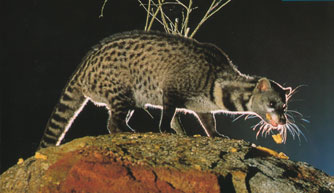
|
Animal
Name: Malay Civet
Scientific
Name: Viverra tangalunga
Range:
Indochina, Malaya, Sumatra
and Borneo
Habitat:
Terrestrial animal, found
mostly on the forest floors though it can climb up low branches.
Diet:
Fallen fruits and small
mammals
Social
structure: Solitary
Life Span:
Wild - 10 to 15 years
Conservation/status:
Not endangered but are
threatened locally.
Remarks:
Not true cats but are more
related to mongooses and raccoons. The secretion of the
African Civet is used in making perfume to create the long
lasting scent effect.
|
|
Animal
Name: Small-toothed /
Three-striped Palm Civet
Scientific
Name: Arctogalidia trivirgata
Range:
Continental Asia and the
Indonesian islands.
Habitat:
Mostly arboreal.
Diet:
Fruit as well as insects,
lizards, frogs, birds and small mammals.
Social
structure: Social and
lives in groups of 10-15 animals.
Life Span:
Wild - 11 yrs
Conservation/status:
Threatened by deforestation.
In some parts of their range, the civets have been known
to rummage through urban garbage dumps, especially during
the night.
Remarks:
The
civet has three
longitudinal stripes along the back and a thin white stripe
along the nose. The coloration of this civet is widely variable,
but there are always three rows of black spots running along
the back. The coat color varies from grayish brown to dark
gray, with the belly yellowish. The tail is longer than
the head and body and is partly prehensile.
Links: Lioncrusher's
Domain,
Palm
Civets.
|
|

|
Animal
Name: Malayan Porcupine
and Indian Crested Porcupine
Scientific
Name: Hystrix brachyura,
Hystrix indica
Range:
Peninsula Malaysia
Habitat:
Forest floors
Diet:
Roots, tubers, leaves
Social
structure: Solitary but
sometimes lives in pairs
Life Span:
Wild - 10 to 15 years
Conservation/status:
Not threatened
Remarks:
Porcupines do not shoot out their
quills, instead they raise up the quills and ram backwards
at the enemy. When the quills get stuck on the enemy, they
are dislodged from the porcupine and the porcupine can escape.
The quills remain on the victim and if they are not removed
soon, the victim will suffer from infection to the wounds.
The quills are in fact modified hair, same material as normal
hair - keratin.
|
|

|
Animal
Name: Sri Lankan Leopard
Scientific
Name: Panthera pardus
Range:
Leopards range
from Africa to Middle East, India, Sri Lanka, China, Indochina,
Southeast Asia
Habitat:
From semi-deserts to dense
forests and open grasslands.
Diet:
Large and small mammals,
birds and reptiles
Social
structure: Solitary
Life Span:
Wild - 12 years, Captivity - 20 years.
Conservation/status:
Endangered, hunted for
fur and as trophies, affected by habitat destruction, shot
by livestock farmers.
Remarks:
Leopards have very strong jaw and
neck muscles that enable them to carry large prey up the
trees to protect from scavengers (especially in the African
grasslands). Leopards of Asia generally hide their half-eaten
prey in bushes where there are fewer rival predators and
scavengers.
Read more about
leopards here.
|
|
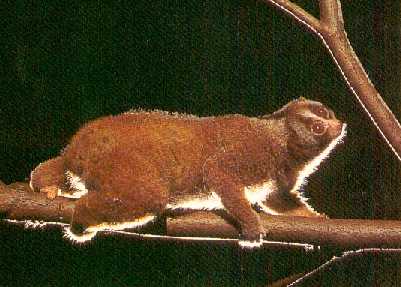
|
Animal
Name: Slow Loris
Scientific
Name: Nycticebus coucang
Range:
Southeast Asia
Habitat:
Lives among trees and bushes
Diet:
Fruits, insects, can raid
birds nest for eggs and nestlings as well as kill roosting
birds.
Social
structure: Solitary.
Life Span:
Wild - 12 to 14 years, Captivity - 20 years.
Conservation/status:
Not threatened, but affected
by deforestation and a victim of the illegal pet trade.
Remarks:
The slow loris is the only venomous
primate. It possesses poison glands near the elbows. When
it is threatened, it will place the elbows over the
face and mix the venom with its saliva, and then it will
bite !
The slow loris
has low metabolism rate and does not generate enough heat
to keep warm, hence it has thick fur despite living in a
tropical climate. The slow loris never jumps from branch
to branch, instead it reaches to the next branch to get
a firm grip first before letting go of the previous branch.
|
|
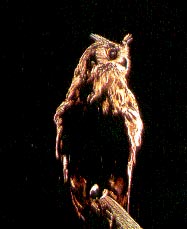
|
Animal
Name: Eagle
Owl
Scientific
Name: Bubo bubo
Range:
North Africa, southern
and central Europe, Scandinavia east to Siberia and China
Habitat:
Wide range of habitats,
from rocky deserts to temperate woodlands
Diet:
Small mammals, birds, reptiles,
amphibians, fish, crabs, insects and spiders.
Social
structure: Solitary
Life Span:
Oldest recorded 21 years
Conservation/status:
Becoming rare due to shooting,
habitat loss, nest robbing by egg collectors, pesticide
poisoning and fatal collisions with power lines and vehicles.
Remarks:
One of the largest owls,
it hunts other birds of prey like buzzards, kestrels and
other owls. It can also kill more powerful birds of preys
like young sea eagles.
Read more about
owls here.
|
|
|
Animal
Name: Golden Cat
(or Fire Cat)
Scientific
Name: Felis temmincki
Range:
Southeast Asia from Nepal
to Burma, China, Thailand, Vietnam, Peninsular Malaysia
and Sumatra.
Habitat:
Dense tropical and sub-tropical
forest
Diet:
Birds, lizards and small
mammals.
Social
structure: Terrestrial
and solitary.
Life Span:
Wild - 10 to 15 years, Captivity - 20 years.
Conservation/status:
Threatened by habitat loss and hunted
for its pelt, listed in CITES Appendix 1.
Remarks:
Not much studies have been done on
this elusive cat. In Asian (likely Thai) mythology, a single
golden cat hair can protect the bearer from tigers. To rid
an entire village of tigers, a whole pelt must be burnt.
Some Thai natives believe that eating the entire cat with
fur will protect them from all animal attacks.
|
|
|
Animal
Name: Clouded Leopard
Scientific
Name: Neofelis nebulosa
Range:
From India, Nepal, Himalayan
Foothills, south China down through Southeast Asia to Sumatra,
Java and Borneo, and also in remote parts of Taiwan.
Habitat:
Lives in dense forests,
usually on branches, high up among the canopies.
Diet:
Birds, monkeys, small mammals
and reptiles.
Social
structure: Solitary, males
are aggressive and have been known to kill females (not
during breeding season).
Life Span:
Wild - unknown, Captivity - 17 years.
Conservation/status:
Under Grade 1 international
protection, nearly went extinct from hunting for its gorgeous-looking
fur. Today it faces more threats from habitat loss and livestock
farmers.
Remarks:
The canine teeth are very
long, the closest to those of the extinct sabre-toothed
tiger among cats today. Its unique voice box prevents it
from roaring. The tail can grow up to 1m long. Read more
about the clouded leopard here.
|
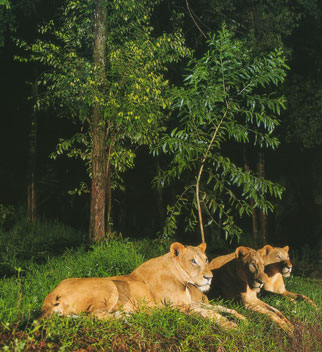
|
Animal
Name: Asian
Lion (or Gir Lion)
Scientific
Name: Panthera leo persica
Range/Habitat:
The Asian Lion can now
be found only in the Gir Forest Sanctuary (1412+ sq km)
in northwest India. A second sanctuary at Kuno Wildlife
Sanctuary (also in India) is selected and being prepared
for the relocation of some Asian Lions from Gir Forest.
Diet:
Mainly deer and antelope,
and also domestic livestock.
Social
structure: Live in family
groups called prides, headed by a single or more mature
males. Due to restricted space in Gir Forest, some solitary
males wander to different prides of females when the latter
come into heat.
Life
Span:
10 - 15 years
Conservation/status:
A victim of sport hunting
in the past. Highly endangered, only about 300 Asian lions
in the sanctuary. Disease, natural disasters and poor gene
pool are obstacles to breeding programs.
Remarks:
Smaller and has a shaggier coat than the African lion, has
a longitudinal fold of skin running along the belly. The
mane of the Asian lion is generally shorter than that of
the African lion and the ears are always visible. Some males
have black manes with more hair at the elbows. Tend to hunt
in smaller groups as prey is small. In danger of being wiped
out by a single epidemic and natural disasters.
To
learn more about the Asian Lions, check out The
Asiatic Lion Information Centre!
|
|
Animals
at the Giraffe Lookout
Area
This
lookout area is only accessible from Tram
Station 2.
Here, one gets a chance to
view a typical African savannah and some of its unique wildlife.
|
|
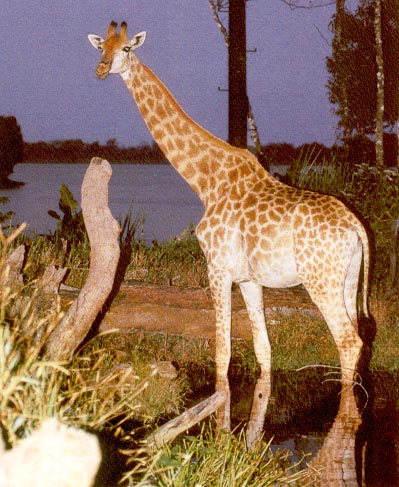
|
Animal
Name: Cape
Giraffe
Scientific
Name: Giraffa camelopardalis
Range:
Southern part of Sahara
desert in Africa
Habitat:
Open Woodlands and wooded
grasslands
Diet:
Leaves from trees, shrubs,
climbers, vines and some herbs.
Social
structure: Loose groups
Life Span:
Wild - 25 years
Conservation/status:
Common in eastern and southern
Africa, numbers have dropped drastically in the west due
to poaching. Overall, giraffes are not threatened yet.
Remarks:
The baby giraffe is born
with its horns flattened against the skull and they pop
up with a week of birth. A newborn weighs a whopping 100kg
and stands at 1.8m tall. An adult grows up to a maximum
height of 6m tall. The giraffe’s tongue can grow up to a
length of 45cm and it uses it to strip shoots from between
thorny branches. The males raise their necks and feed from
high up while the females bend their necks down to feed,
hence both sexes are not in direct competition for food.
|
|
|
Animal
Name: Scimitar-horned
Oryx
Scientific
Name: Oryx dammah
Range:
Morocco, Mauritania and
Senegal to Tunisia
Habitat:
Semi-deserts
Diet:
Grasses, herbs, berries,
leaves, bulbs and fruits.
Social
structure: Travels in herds
Life Span:
20 years
Conservation/status:
Hunting (for horns as trophies
and for skins as leather) and loss of habitat have greatly
diminished their numbers.
Remarks:
Smallest of the 3 species
of oryx, The oryx can survive for long periods without water,
deriving most of its moisture from the plants it eats. Their
light color coat can help to reflect off sunlight, keeping
it cool.
|
|
|
Animal
Name: Thomson’s
Gazelle
Scientific
Name: Gazella thomsoni
Range:
Kenya, Tanzania and Sudan
Habitat:
Dry grasslands
Diet:
Grass
Social
structure: Live in herds
Life Span:
10 - 15 years
Conservation/status:
Protected in wildlife parks.
Elsewhere, it faces increasing habitat loss and competition
from domestic livestock.
Remarks:
A favourite prey of the
cheetah, they can sprint up to 80km/h, males have longer
and larger horns with spiral patterns on them than females,
who have smaller, straighter and smooth horns.
|
Acknowledgements
- Animal
Facts from Wildlife Fact Files,
classroom
sessions and informal interviews with zoology staff of WRS, Photos
from Night Safari.
Look
at this current
Leopard Trail map, have you explored all the places
yet?
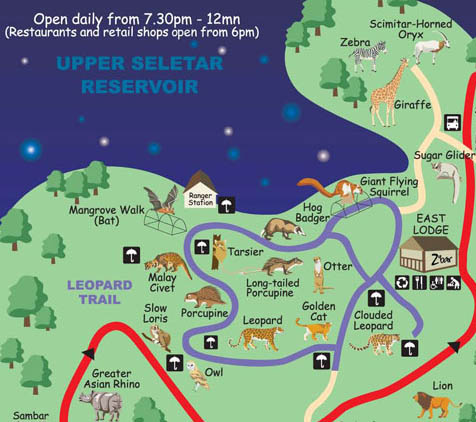
Things
to ponder...
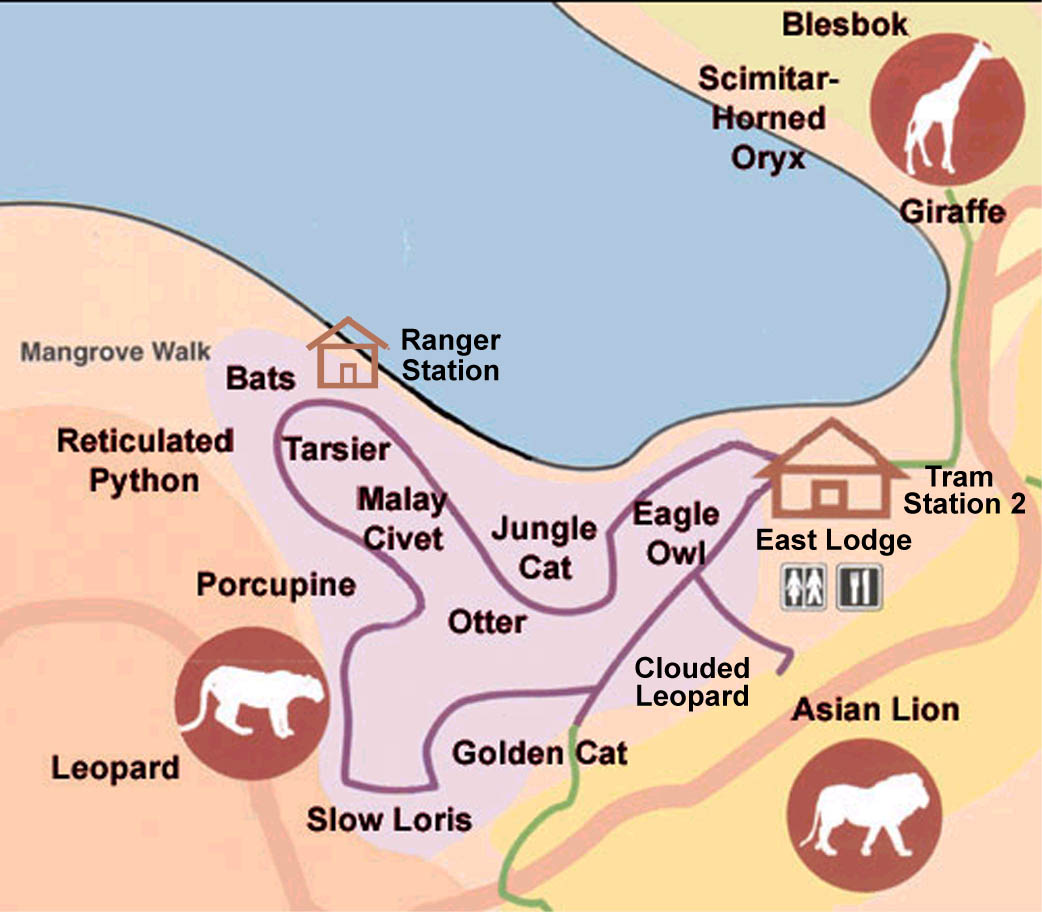
Do
you know that some of the animals on this
old Leopard Trail map have
shifted homes while others have been
'retired'?
Do
you know how to direct the guests to the Giraffes from
the Ranger
Station?
If
the guests want to return to the Main Entrance/Tram Station
1, how do you direct them?
Hint:
Return to the Walking Trails page below and look at the
complete map of Night Safari.
Let's
go to the next trail, choose one!
Fishing
Cat Trail
Forest
Giants Trail
Home
| Explore
| Rangers’ Station
| Walking Trails
| Tram Ride
| Resources
|
©
2009 NSRangers.Tripod.com. All rights reserved.
|
|





